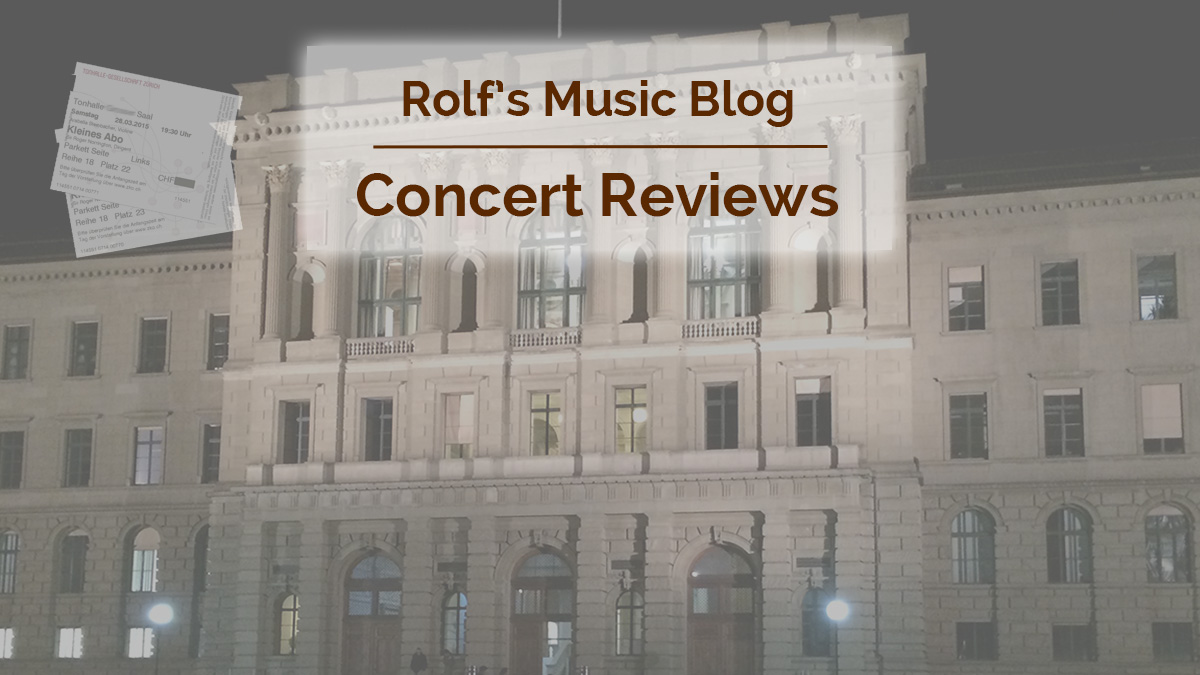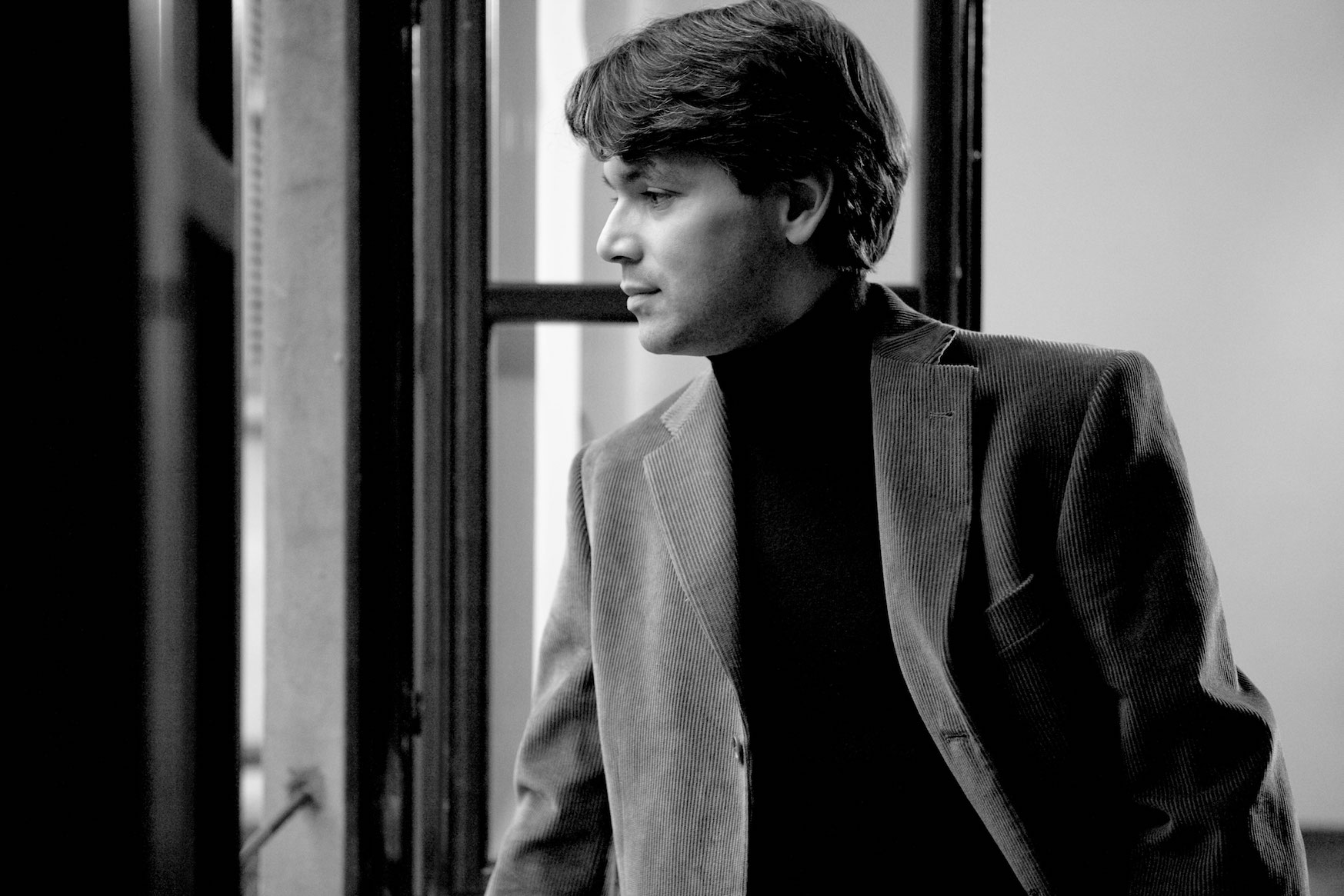Piano Recital: Pietro De Maria
Chopin / Ligeti / Liszt
Semper-Aula, ETH Zurich, 2016-10-25

2016-10-28 — Original posting
Table of Contents
Introduction
Concert Setup / Venue
The organizer for this recital was Musical Discovery. The concert was part of the series “Musik an der ETH” (music at the Swiss Federal Institute of Technology in Zurich). The venue for the recital (as well as most other concerts in the same series) is the historic Semper-Aula in the main building of the ETH. It’s a listed / protected hall. The room remains in its original, partly finished state. Many of the paintings are sketches only, or have not been colored. The use of the venue is subject to restrictions, allowing only audiences up to 99 people. For this concert, the venue was full. The piano is a Steinway model D concert grand, which I found to be in excellent condition in this concert.
The Artist
Pietro De Maria (born 1967) grew up in Venice, where he also received most of his piano education and graduated from the Conservatory of Venice. He continued his studies at the Conservatoire de musique de Genève, under Maria Tipo (*1931), finishing off in 1988 with the Premier Prix de Virtuosité. Pietro De Maria has won prizes at several competitions—starting at age 13 in Milan, where he won the first prize at the Alfred Cortot International Piano Competition.
His career as a soloist really took off after he won the Critics’ Prize at the Tchaikovsky Competition in Moscow (1990). In the same year he finished off at first position at the “Dino Ciani – Teatro La Scala in Milan” competition, in 1994 the Géza Anda Competition in Zurich, and in 1997 the Mendelssohn Award in Hamburg. De Maria is since pursuing an international career as soloist, playing with many prominent orchestras and conductors. For additional information see also the Italian Wikipedia site.
Currently, Pietro De Maris is also teaching at the Scuola Musica Fiesole, at the Accademia di musica Pinerolo and at the PIANALE International Piano Academy in Schloss Hallenburg, Schlitz/Germany.
Starting a Recital
Pietro De Maria is also an active recording artist. Actually, he is one of the very few pianists who have recorded Frédéric Chopin’s entire oeuvre for solo piano, on 13 CDs (see the CD reference at the bottom). So, one can expect him to be an experienced, seasoned performer of Chopin’s music.
When he entered the hall, he immediately struck me as a very friendly, pleasant personality, his behavior as modest, temperate, unobtrusive: certainly not an extroverted, boisterous virtuoso!
Whatever the personality: even for seasoned, firm and experienced artists, starting a recital may not be as easy as some people in the audience might think. Even if the artist has rehearsed extensively, and even if those rehearsals happened on the concert instrument, the presence of an audience changes the situation fundamentally. The artist need to adjust to the altered acoustics (the audience changes the amount of reverberation, etc.), and hence mentally adjust to the presence of an audience.
Even more important, and apart from the artist’s subjective situation, artists wants the full attention of the audience, and so they needs to change people’s focus from their daily duties and chores onto the concert, onto the music. Some artists might try breaking that (mental) barrier by jumping “onto” the instrument, to start immediately, in the sense of “close your eyes, jump and dive!”. For example, an artist may select a particularly loud or busy piece in order to circumvent the barrier. In opera, the overture has a similar function. A frequently selected solution for recitals would be, to select a musically and/or technically simple piece for starting, before playing the core pieces of the program.
Works by Frédéric Chopin (1810 – 1849)
Pietro De Maria chose a different solution to getting started with the recital. He decided to give some explanations into the Mazurka (Polish: Mazurek, plural Mazurki), more specifically, Chopin’s Mazurki—a musical form (a popular folk dance from a specific region in Poland) that has accompanied the composer throughout his entire life. De Maria called these works the “most Polish” among Chopin’s compositions. The artist pointed out the rhythmic peculiarities of the Mazurka, which is always in 3-time meter, but the accent may be on the first, the second or on the last beat, as there are slow as well as fast variants. De Maria also pointed out the elevated fourth as harmonic peculiarity in some of the Mazurki.
These instructions were very instructive and helpful. The pianist gave them while sitting at the instrument, and he illustrated his points with suitable examples. This way, he not only broke the barrier for himself, for his own playing, but he also established a connection to the audience, in an ideal way. Once the “ice” was broken, De Maria played three representative examples from Chopin’s oeuvre of (at least) 58 Mazurki:
Mazurka in F minor, op.7/3
This first example was from the 5 Mazurki op.7, composed 1831/1832, published 1832. The Mazurka in F minor, op.7/3, from 1831, actually is a slow Mazurka, an example of the sub-type Kujawiak.
The Performance
To me, as non-Polish Western European, this first piece felt sad and melancholic, almost depressive; just in the middle part, the music brightens up a little. Pietro De Maria played this in a distinctly (but very fittingly, I think) slow tempo. All of his Mazurki were slower than (for example) any of Arthur Rubinstein’s interpretations. This particular one felt hesitant, restrained, with a rather strong (and also well-fitting) rubato. An excellent start of the recital, I would say!
Mazurka in C major, op.24/2
Chopin wrote the 4 Mazurki op.24 in 1836. The Mazurka in C major, op.24/2 stands in strong contrast to the first example above: it is a fast dance (Allegro non troppo) of the (sub-)type Oberek.
The Performance
To me, this piece felt like a mix of moody and happy-joyful. The contrasting trio (in D♭ major) seemed soliciting, if not a little rebelling, while the left hand seemed to imitate stomping as in typical country dances.
Mazurka in C♯ minor, op.63/3
The third and last example was from the 3 Mazurki op.63, which Chopin composed 1846 (published 1847): these are the last Mazurki published during the composer’s lifetime. The Mazurka in C♯ minor, op.63/3 (Allegretto) is an example for a Mazurka with elevated fourth stage in the scale.
The Performance
A rather pensive piece, in which I particularly liked De Maria’s careful dynamics and tempo disposition.
Ballade No.1 in G minor, op.23
The Ballade No.1 in G minor, op.23 (CT 2, the first of four that Chopin wrote) was composed in 1831. It begins with a slow introduction and ends at a fast pace: Largo (4/4) — Moderato (6/4) — Presto con fuoco (2/2). More (related and anecdotal) information on the piece is available from Wikipedia.
The Performance
Here, the spectrum of expression appeared expanded substantially. The introduction appeared thoughtful, almost dreamy, maybe a little playful. De Maria’s playing felt introverted, almost modest initially, retained also in the harmonious phrasing arches. Towards the climaxes, the pianist accelerated substantially, up to a fairly fast tempo, unfolding even grandiose splendor. Yet, virtuosity never appeared superficial—not even a trace—or self-purpose: it was merely a required and solid base for the artist’s playing.
Nocturne D♭ major, op.27/2
The 2 Nocturnes op.27 were composed 1836, published 1837. The Nocturne D♭ major, op.27/2 (CT 115) is annotated Lento sostenuto.
The Performance
Pietro De Maria’s facial expression almost felt as if he was afraid if single notes that could accidentally be too hard, too loud, or inappropriately stand out otherwise. Yet, the piece to me did not appear excessively dreamy or overly solemn. At a small scale, I noted De Maris’s rich, rather strong agogics, which tended to hinder the flow of the music. I also felt that it directed too much attention onto motifs and details in the melody. On the other hand, I liked the overall, wide-spanning big arch, the harmonious, organic evolution.
Scherzo No.2 in B♭ minor, op.31
The Scherzo No.2 in B♭ minor, op.31 (Presto)—one of four that the composer wrote—appeared in print in 1837.
The Performance
As in the preceding Ballade, Pietro De Maria avoided harshness in the articulation; he diligently (occasionally maybe almost excessively?) used the sustain pedal, avoided overblown attitude or playing. Also the dynamics were always well-controlled. Yet, De Maria’s playing never had the flavor of being instructive, “ex cathedra”, or overly intellectual. And as in the Ballade, the artist built up the pace, up to a very fluent pace. But also here, he proved to be a master of nuanced keyboard touch.
Overall / general impressions from the first half of the concert: De Maria often seemed to play with his eyes closed, immersed in his world, while definitely sensing the presence of the audience, the connection to the listeners. The impression that he occasionally (judging from his spontaneous facial expressions) was scared of accidental, excessively loud chords or notes must be deceptive, though…
Works by György Ligeti (1923 – 2006)
Non-pianists in the audience may not have been familiar with György Ligeti‘s music—therefore, it was an excellent idea for the pianist to start also the second half of his recital with brief, but very helpful explanations and examples, particularly on Ligeti’s 18 Études, but also on Ligeti’s music in general, what inspired the composer. This not only helped re-starting the recital, it also was helpful in re-orienting the listener’s mind from Chopin to music of the 20th century.
Ligeti wrote 18 Études, organized in three volumes: Book I (Nos.1 – 6), Book II (Nos.7 – 14), and Book III (Nos.15 – 18). The selection chosen for this recital was from the first two books:
Étude No.8: Fém (“Metal”, from Book II)
Étude No.8 (from Book II), Fém. The title Fém is Hungarian for “Metal”, symbolized by “hard” fifths played in rapid, irregular succession.
The Performance
Here, we met an entirely different style of playing: De Maria almost playfully offered the strongly rhythmic, “hammered” / “metallic” fifths and seconds, the contrasts between the hard chords in the middle and upper registers and the softer grumbling in the bass register.
Étude No.5: Arc-en-ciel (“Rainbow”, Andante con eleganza, from Book I)
Étude No.5 from Book I bears the title Arc-en-ciel (“Rainbow”): Andante molto rubato con eleganza, with swing. Despite the many dissonances, it is a very atmospheric piece. The rainbow is not seen in a trivial way (up on one side, rising to the top, down again at the end). At best, one could find a bow-like structure (soft — loud — soft) in the overall dynamics.
The key in this piece is the atmosphere. At the very end, Ligeti makes the music rise to, fade away into the very top end of the keyboard (where, frankly, the sound of the hammers was—and typically is—stronger than the actual tones played). De Maria called this a signature feature in Ligeti’s music (other pieces, such as the Étude No.6 from Book I, may do the opposite and end by descending into the bottom end of the keyboard). He interpreted the ending in Arc-en-ciel as “disappearing into eternity”.
The Performance
In this Étude, De Maria clearly and aptly differentiated between arpeggiated (softer) and “hard” chords.
Étude No.13: L’escalier du diable (“The Devil’s Staircase”, from Book II)
Among pianists, Étude No.13 (from Book II), L’escalier du diable (“The Devil’s Staircase”) is definitely the most popular and most frequently played among Ligeti’s 18 Études. The reason for its popularity is not (or not primarily) that it features an infamous ffffffff (sic!) annotation (the audience was forewarned!. Rather it is in its interesting melodic, rhythmic and polyphonic structure. In the form, this Étude actually is a Toccata.
The “Devil’s Staircase” is not about a staircase leading down to hell, but rather—and much more devilishly—an infinite ascent that never reaches its goal. The easiest way to picture this (and also what inspired György Ligeti) is through Maurits Cornelis Escher‘s (1898 – 1972) peculiar, irritating drawings of endless, circular staircases:
The Performance
It’s an absolutely fascinating piece which justifies its popularity among pianists. The most interesting thing is how Ligeti achieves the “perpetual ascending”. And yes, it sometimes is very loud! The most impressive feature was not so much in the virtuosic, polyphonic, chromatic ascent; rather, at the very end there is this “endless” fading of the last bass chord into the absolute silence. This, (felt and factually) lasted over a minute, to the point when one could no longer perceive the releasing of the dampers. Fascinating, thrilling music, very well-played!
Works by Franz Liszt (1811 – 1886)
The official program closed with thee vastly different pieces by Franz Liszt:
From “Soirées de Vienne, 9 Valses-Caprices d’après Schubert”: No.6 in A minor, S.427/6
In these “Valses-Caprices”, Liszt “digested” sections / pieces from the Valses sentimentales, D.779, and from the 12 Valses nobles, D.969, by Franz Schubert (1797 – 1828). Valse-Caprice No.6 in A minor (Allegro con spirito) is from 1852. It is not just a mere transcription, but a Liszt-style, virtuosic piece, with interspersed “Schubertian” sections.
Valse-Caprice No.6 exists in two versions. The (more popular) first version (which De Maria played) is more compact and brilliant. The second version (Allegro spiritoso — Allegretto malinconico — Allegro spiritoso — Poco meno mosso, amorosamente) is more restrained, longer, and more lyrical.
The Performance
In Pietro De Maria’s hands, the “Lisztian” beginning did not appear extroverted, did not demonstrate virtuosity, but was rather playful. The song-like “Schubertian” segments (Scherzando con grazia, even more so the Teneramente) really felt like an Impromptu by Schubert, dreamy, often hesitating. The agogics were often almost extreme. Even more so the rubato: it was rubato in the proper sense, in that after a delay the pianist typically appeared to “catch up” to the regular pace again. Even though De Maria played the more brilliant, first version of the piece, his playing overall remained somewhat restrained, controlled, careful. It wasn’t the show of a magician and circus artist, as with Vladimir Horowitz (1903 – 1989).
From “Années de Pèlerinage, Deuxième Année – Italie”: No.5, Sonetto 104 del Petrarca
The “Années de Pélerinage” consists of three suites that Liszt wrote between 1837 and 1877. Liszt composed the second Suite “Années de Pélerinage: Deuxième année: Italie“, S.161, between 1837 and 1849. For this recital, Pietro De Maria selected No.5, “Sonetto 104 del Petrarca”.
The Performance
This appears like a rather earnest, mysterious, pensive piece. Still, De Maria showed also the poetic aspects in this music, made it sometimes sound melancholic, sometimes also playful. The artist understood how to make complex textures sound simple, natural, compact. Virtuosity not as self-purpose, even in fioriture, in passages with complex polyphony / polyrhythmics, or in the garlands in the central cadenza.
From Grandes Études de Paganini, S.141: Étude No.3 G♯ minor, “La Campanella”
The “Campanella” (little bell) Étude is a well-known, virtuosic showpiece. Liszt derived the melody from the final movement of the Violin Concerto No.2 in B minor by Niccolò Paganini (1782 – 1840).
The Performance
Pietro De Maria may have disappointed those who expected the craziness, the extravaganza of artists such as Georges Cziffra (1921 – 1994). As in the other pieces, De Maria avoided exaggerations or abrupt transitions, carefully formed the build-ups. His playing remained smooth and controlled—despite all his obvious pianistic abilities, the inherent virtuosity in his playing.
Encore 1 — D. Scarlatti: Sonata in D minor, K.1
The audience in this concert may have been small—it still gave an enthusiastic applause, leading to two encores. The first of these was the Sonata in D minor, K.1 (L.366, Allegro), by Domenico Scarlatti (1685 – 1757): a relaxed piece, full of playful trills. —
Encore 2 — Chopin: Waltz No.7 in C♯ minor, op.64/2
Finally, Pietro De Maria offered the Waltz No.7 in C♯ minor, op.64/2 (Tempo giusto) by Frédéric Chopin (1810 – 1849). The artist started rather introvertedly, but then switched to impressive accelerandi. He made the waltz scurry along almost eerily, in-between returning to pensive moments.
Conclusion
I would call Pietro De Maria a master of poetry in piano playing, a master of controlled dynamics and of keyboard touch. I equally admire his agogics, his rubato, and his natural, inconspicuous virtuosity. The strong applause was well-deserved.
Addendum: CD
Here’s Pietro Maria’s complete recording of all of Frédéric Chopin’s solo piano works (I’m providing this just for reference — so far I have not purchased this CD box myself, nor have I even just listened to excerpts):
Chopin: Complete Piano Works
Pietro De Maria, piano
Decca 481 116-7 (13 CDs, stereo); ℗ 2006 – 2009 / © 2014

Addendum 2
For the same concert, I have also written a (shorter) review in German for Bachtrack.com. This posting is not a translation of that German review, the rights of which remain with Bachtrack. I create the German review using a subset of the notes taken during this concert. I wanted to enable my non-German speaking readers to read about my concert experience as well. Therefore, I have taken my original notes as a loose basis for this separate posting. I’m including additional material that is not present in the Bachtrack review.







